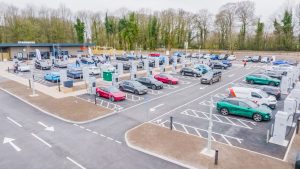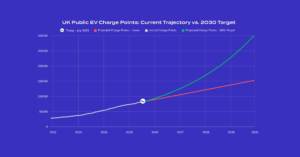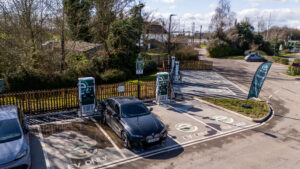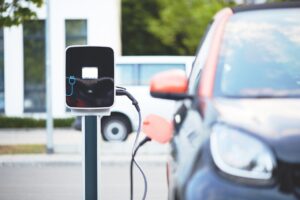The rollout of electric vehicle (EV) chargers across Europe is accelerating. But as the network expands, a new challenge has emerged: quality and capacity now matter more than raw numbers. What matters to drivers is whether the charger is available, working, and capable of delivering a meaningful top-up in the time it takes to grab a coffee.
In 2024, one in four new cars sold in Europe was electric, with over 14.5 million EVs now on the road. Public charging points have multiplied to support that growth. The EU had over 632,000 public chargers by the end of 2023, with around 153,000 added that year alone. Yet most of those are slow AC chargers delivering 22 kW or less. Enough for overnight top-ups, but not for long-distance drivers or commercial fleets.
According to the European Alternative Fuels Observatory, just 13.5% of EU public chargers offer more than 22 kW. That is a loose definition of “fast,” and includes many 43 kW AC units that fall short of the expectations set by petrol stations. In the UK, where the government sets the “rapid” threshold at 50 kW, around 20% of chargers qualify. The difference is significant. In Britain, rapid chargers make up a fifth of chargers by count but deliver around 60% of total public charging energy. This is the direction Europe needs to head.
Public charging infrastructure will need to scale dramatically by 2030 to keep pace with EV uptake. The EU is targeting around 3.5 million public chargers by 2030 (up from around 0.6 million now), which requires deploying over 400,000 new chargers per year. But meeting that target is not only a matter of volume. It’s a matter of ensuring those chargers are useful, accessible, and powerful enough to meet the expectations of EV drivers who are increasingly relying on their vehicles for long-range and commercial use.
Why Naming Conventions Complicate the Conversation
A quick note on terminology. The EV charging sector has no universally agreed naming system. What is considered “rapid” in one country might be “standard” elsewhere. In the UK, 50 kW is the benchmark. In Europe, 22 kW is often the cut-off. Some organisations use “high-power” to mean anything above 150 kW. Others lump together everything from 22 to 350 kW as a single category.
This complicates policy planning and makes cross-border data comparisons more difficult than they should be. It also obscures the real challenge. Chargers need to be powerful enough to serve short-stop use cases reliably, and the number that meet that bar is still relatively low.
It is also worth noting that these definitions will not remain fixed. As charging speeds and battery technology improve, the industry’s benchmarks will shift. Ten years ago, a 50 kW charger was considered cutting edge. Now, many vehicles can charge at over 150 kW, and 350 kW hardware is becoming standard along major motorway corridors. Today’s “ultra-rapid” will be tomorrow’s minimum.
Density and Distribution: Geography Matters
The EU’s charger rollout has been impressive in raw numbers, but lopsided in geography. Just three countries, the Netherlands, France and Germany, host more than 60% of all public chargers. The Netherlands leads the charge (pardon the pun) in charger density with roughly one charger for every five EVs, far better than the 1:10 ratio recommended by ACEA. But it is worth noting, many of those Dutch chargers are low-power AC sockets.
The UK has ramped up its rollout rapidly, reaching around 82,000 public chargers by mid-2025. About one-fifth are 50 kW or higher. Its chargers are begining to spread across both dense cities and rural corridors, but more work needs to be done to ensure every corner of the country is served, just like the fossil fuel alternatives. Despite being outside the EU, the UK’s network scale now rivals France or Germany.
Fast-charger density, however, tells a different story. The EU average is around 29 BEVs per fast charger. In Norway, that figure exceeds 30 per charger in high-adoption cities. This gap will become more apparent as more drivers expect petrol-station-level convenience, and EV adoption accelerates.
Lower powered chargers, especially those aimed at serving long dwell times in workplaces or residential streets, still have a vital role. But they cannot shoulder the entire burden of electrification. High-power chargers are not just useful for the handful of long road trips each year. They are essential for confidence, accessibility, and the heavy-use needs of taxi fleets, logistics operators and drivers without home charging.
Regulations Are Raising the Bar
Europe is not ignoring this problem. The Alternative Fuels Infrastructure Regulation (AFIR), passed in 2023, sets binding targets to address power density and network consistency. By the end of 2025, AFIR mandates that at least one 150 kW charger must be available every 60 km along core TEN-T corridors. Total site capacity must reach at least 400 kW by 2025, rising to 600 kW by 2027.
AFIR also insists on contactless payment, price transparency, and real-time availability data, turning the high-power charger from a piece of hardware into a piece of trusted infrastructure. In short, the policy is no longer focused on plugs. It is focused on performance.
In the UK, Public Charge Point Regulations introduced in 2023 now require 99% uptime for rapid chargers, enforceable by government. The regulations also mandate contactless payment and around-the-clock customer service. The goal is parity with petrol stations, not just in speed, but in reliability. Networks will need to report on performance and fix outages quickly to avoid penalties.
This is forcing charge point operators and infrastructure providers to rethink how they deliver sites. Installations must now meet not only speed requirements, but also robust design, seamless payment, high reliability, and future-proof grid capacity. Additionally, modularity and upgradability are baked into the regulations and something that should be front of mind when rolling out new sites. These expectations mark a shift: charging is becoming part of national infrastructure, not just a niche product.
Hubs Build Confidence. Hubs Build Volume.
Installing a high-power charger is only half the equation. The bigger play is building full-service, multi-bay charging hubs with proper lighting, signage, surveillance and driver comfort in mind. These are not just functional spaces, they are trust signals.
At InstaVolt’s flagship Winchester hub, drivers find multiple 150 kW+ chargers under weatherproof canopies with clear wayfinding and retail access. The design echoes conventional fuel stations, creating familiarity and ease of use. According to InstaVolt’s CEO Delvin Lane, road signage and site layout are crucial for confidence, again highlighting the importnance of the site elements over and above the chargers themselves.
Formula Space’s own work with Schroders Capital and Be.EV underscores the point. Their joint programme will see over 200 ultra-rapid charging bays installed across 22 UK retail parks, each built around a repeatable, full-site design strategy: canopy, bay markings, lighting, security, and cable protection.
These elements reduce downtime, support 99% uptime requirements, and make the site inviting to all drivers, even those that haven’t made the EV switch yet. Importantly, they make scale possible. A hub that works well for four chargers can work for 12 or more if the foundations are solid, literally and figuratively.
A canopy is not just a weather cover. It protects equipment from wear, reduces maintenance, and improves accessibility for users plugging in during bad weather. Consistent bay markings and signage help avoid misuse or ICEing, while security features like CCTV and physical cable protection deter vandalism and theft. These design details translate directly into improved uptime and driver satisfaction.
The Bottlenecks: Grid, Permits and Practicalities
If high-power hubs are so clearly the future, why are they not everywhere yet? Grid constraints are a major blocker across Europe, particularly in older urban areas or along motorway corridors. Getting a site connected at the necessary power level can involve substation upgrades, months-long waits and high costs.
Permitting and planning is another culprit. Delays in securing approval for canopies, signage, or grid connection points often outlast the construction time itself. Each country, and in some cases, each region, has its own rules, timelines and red tape. Some governments are working to harmonise or fast-track approvals, but patchiness remains.
Construction complexity is often underestimated. A modern charging hub is not just a charger and a cable. It involves trenching, ducting, reinforced foundations, crash protection, signage installation, and site security, often requiring multiple contractors. Coordination can be a project in itself as well as the experience and foresight needed to design the site to be easy to maintain, future-proof and cost effective to construct. This is where the value of a dedicated delivery partner.
Funding is the final constraint. While investment is flowing, the EU’s Connecting Europe Facility and the UK’s 400 million pound Rapid Charging Fund are examples the economics of a 12-bay 300 kW hub are still front-loaded. Returns come with volume, and volume comes with trust. It is a catch-22 that only good delivery can break.
Delivery Is the Missing Link
For governments and charge point operators, the challenge is not ambition. It is execution. This is where Formula Space places itself, in the physical delivery of hub-grade infrastructure, from modular EV foundations to eco-rated canopies and CableGuard® cable protection.
Formula Space’s modular foundation systems are delivered pre-assembled, with generous cable management apertures and intelligent retention systems that keep chargers stable and simplify future upgrades. Foundations are matched to CPO and OEM specifications, and allow for easy bolt-down installation without waiting for concrete to cure. This reduces both construction time and cost.
InstaVolt, Be.EV and Schroders are already seeing the benefits of this full-site approach. Using Formula Space’s modular system, foundations and canopy supports can be installed and ready for charger placement in under a day. That speed matters. It is not just time saved on site, it is revenue, uptime and driver retention gained in the long term.
Solutions like CableGuard®, developed in response to on-site cable thefts that caused outages, are being incorporated from the outset to reduce downtime and maintenance costs. Anti-theft and anti-vandalism features like this are no longer optional, they are essential to meeting regulatory targets for uptime and delivering on customer expectations.
With EV adoption rising and infrastructure regulation tightening, the race is no longer just for plugs in the ground. It is for dependable, high-performance hubs that drivers can trust, operators can maintain, and policymakers can point to as real-world proof that electrification is not just happening, but working.
Building the physical space around the charger is how Europe will unlock the next phase of electrification.
Sources and References
European Alternative Fuels Observatory (EAFO) – Data on EU charging infrastructure counts, charger speeds, and national comparisons.
https://alternative-fuels-observatory.ec.europa.eu
ACEA (European Automobile Manufacturers Association) – 2024 reports on infrastructure rollout targets, charger-to-EV ratios, and national disparities.
https://www.acea.auto
IEA Global EV Outlook 2025 – For Europe-wide EV sales, growth trends, and charging infrastructure forecasts.
https://www.iea.org/reports/global-ev-outlook-2025
European Commission – Alternative Fuels Infrastructure Regulation (AFIR) – Official 2023 legislation setting binding charger requirements and rollout targets across TEN-T corridors.
https://transport.ec.europa.eu/transport-themes/clean-transport-urban-transport/electric-mobility/alternative-fuels-infrastructure_en
UK Department for Transport – Electric Vehicle Infrastructure Statistics: January 2025 – UK-specific data on public charger counts, rapid charger share, and rollout pace.
https://www.gov.uk/government/statistics
Public Charge Point Regulations 2023 (UK) – Government policy setting 99% uptime, contactless payment and service standards.
https://www.legislation.gov.uk/uksi/2023/1095/contents/made
Zapmap (2025) – Live and annual data on UK public chargers by type, location, and network.
https://www.zap-map.com
Transport & Environment (2024) – Research and recommendations on charger rollout pace, EV uptake, and regulatory enforcement.
https://www.transportenvironment.org
InstaVolt (2024) – Press release on EV signage, site standards, and forecourt design principles.
https://www.instavolt.co.uk/news
Zapmap x Be.EV / Schroders announcement (2025) – Details of £20m rollout of ultra-rapid hubs at retail sites.
https://www.zap-map.com/news













